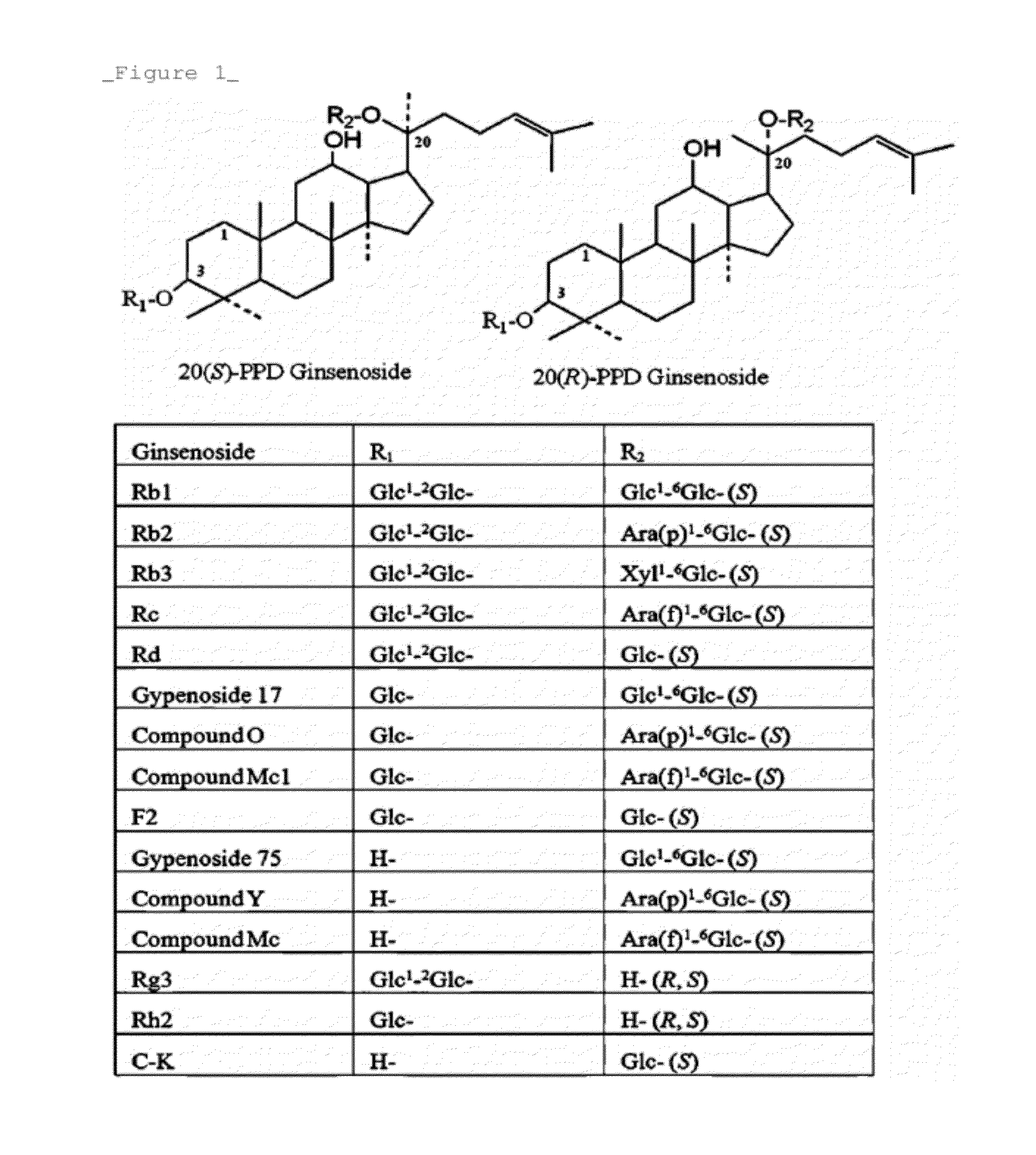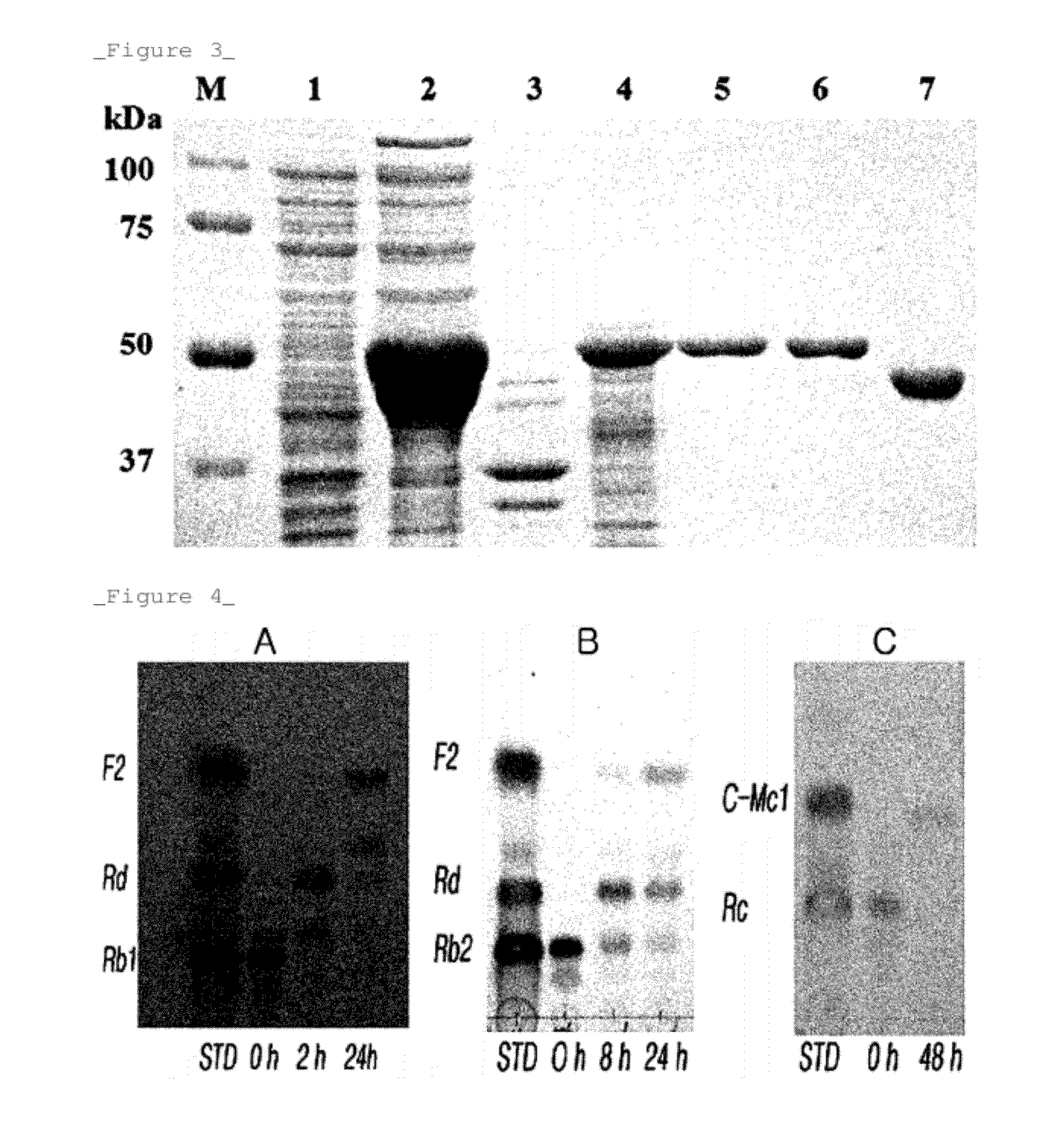Rhodanobacter Ginsenosidimutans KCTC22231T-Derived Ginsenoside Glycosidase, and Use Thereof
a technology of ginsenoside glycosidase and rhodanobacter ginsenosidimutans, which is applied in the field of rhodanobacter ginsenosidimutans kctc22231t-derived ginsenoside glycosidase protein, can solve the problems of low in vivo absorption, low yield, and difficulty in producing a large amount of ginsenoside f2, and achieve excellent sap
- Summary
- Abstract
- Description
- Claims
- Application Information
AI Technical Summary
Benefits of technology
Problems solved by technology
Method used
Image
Examples
example 1
Fosmid Library Screening and Full Sequence Analysis
[0079]A CopyControl Fosmid Library Production Kit (Epicentre, U.S.A) was used according to the manufacturer's instructions. The genomic DNA of Rhodanobacter ginsenosidimutans KCTC22231T was randomly cleaved to a fragment of approximately 40 Kb. A small amount thereof was electrophoresed by Pulsed Field Gel Electrophoresis to determine the size of the cleaved DNA. The blunt, 5′-phosphorylated end was prepared by end-repair. The end-repaired DNA of 40 Kb or longer was selected by LMP (low melting point) agarose gel electrophoresis. The blunt end DNA was purified from the LMP agarose gel, and ligated into at pCC1FOS vector. A MaxPlax lambda packaging extract kit (Epicentre, U.S.A.) was used to perform in vitro packaging. Finally, the product was transfected into E. coli EPI300-T1R that was cultured in LB broth containing 10 mM MgSO4 until the OD value at 600 nm reached 0.6. Absorption of the transfected bacteria was allowed at 37° C. f...
example 2
Molecular Cloning, Expression, and Purification of bgl3054
[0081](2-1) Molecular Cloning and Expression of bgl3054
[0082]The assembled DNA sequence of pbgl3054-p1 was analyzed using a genetic code 1 and Vector NTI v10.0 (Invitrogen Inc.). ORF of ginsenoside glycosidase was found, and the template pbgl3054-p1 DNA was amplified by PCR using the following oligonucleotide primers.
Forward primer:(SEQ ID NO. 5)5′-CGG ATC CAA TGG GCC TGG GAC GCC GGC GT-3′Reverse primer:(SEQ ID NO. 6)5′-CGG AAG CTT TCA GGC GGG CTG CGG TGC-3′
[0083]The amplified fragment was sequentially cloned into a pHis-Parallel expression vector (used by introduction of EcoRI and HindIII restriction sites) and a recombinant TEV protease (rTEV)-containing His6 (hexahistidine) fusion protein expression vector, pHis-Parallell. Next, the recombinant vector pHisBGL3054 was introduced into E. coli C41 (DE3).
[0084](2-2) The Results of Cloning and Expression of bgl3054
[0085]The ginsenoside glycosidase showed the ability of convert...
example 3
Enzyme Characterisation
[0092]Specific activity was measured using 90 _l of 50 mM sodium phosphate buffer containing 2.0 mM pNPGlc (p-nitrophenyl-_-D-glucopyranoside; Sigma) at pH 7.0, and 10 _l of the diluted purified enzyme was treated at 37° C. for 20 minutes before initiation of the reaction, followed by incubation. 0.1 ml of 1 M Na2CO3 was treated for 5 minutes to terminate the reaction, and the concentration of p-nitrophenol was immediately measured at 405 nm. One unit of activity was defined as the amount of enzyme that released 1 _mol of p-nitrophenol per minute. Specific activity is expressed in units per milligram protein. Protein concentration was measured using a Bio-Rad protein staining reagent according to the protocol. All analyses were performed at least three times.
[0093](3-1) Measurement of pH Effects
[0094]The effect of pH on the enzymatic activity was measured.
2.0 mM pNPGlc (p-nitrophenyl-_-D-glucopyranoside; Sigma) was used as a substrate, and pH was adjusted usin...
PUM
| Property | Measurement | Unit |
|---|---|---|
| temperature | aaaaa | aaaaa |
| OD | aaaaa | aaaaa |
| pH | aaaaa | aaaaa |
Abstract
Description
Claims
Application Information
 Login to View More
Login to View More - R&D
- Intellectual Property
- Life Sciences
- Materials
- Tech Scout
- Unparalleled Data Quality
- Higher Quality Content
- 60% Fewer Hallucinations
Browse by: Latest US Patents, China's latest patents, Technical Efficacy Thesaurus, Application Domain, Technology Topic, Popular Technical Reports.
© 2025 PatSnap. All rights reserved.Legal|Privacy policy|Modern Slavery Act Transparency Statement|Sitemap|About US| Contact US: help@patsnap.com



